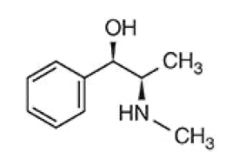22B13: Exam Report
Compare and contrast the pharmacology of EPHEDRINE and METARAMINOL
27% of candidates passed this question.
The ‘compare and contrast’ pharmacology question indicates the use of a standardised structure that incorporates pharmaceutics, pharmacokinetics and pharmacodynamics.
The best answers provided excellent detail, ie. precise descriptions of mechanisms of action and emphasised noteworthy areas of contrast between the two drugs.
Highlighting opportunities for use and areas of caution/drug limitations.
Overall, most candidates seemed to have a sufficient knowledge of metaraminol but details surrounding
ephedrine were often lacking.
G7i / 22B13: Compare and contrast the pharmacology of EPHEDRINE and METARAMINOL
Metaraminol
Ephedrine
Metaraminol
Synthetic catecholamines

Ephedrine
Synthetic Non-catecholamines

Pharmaceutics
Class
Metaraminol
- Synthetic catecholamine
Ephedrine
- Indirect / direct acting
Receptors
Metaraminol
- α1 (mostly)>> β1
Ephedrine
- α1 + β1
Use
Metaraminol
- Refractory hypotension
Ephedrine
- Hypotension in general, spinal or epidural anaesthesia
- Nocturnal enuresis
- Narcolepsy
- Diabetic autonomic neuropathy
- Hiccups
- Nasal decongestant
Presentation
Metaraminol
- CCS 10mg/mL
Ephedrine
- 15/30/60mg tabs
- Elixir
- Nasal drops
- CSI 30mg/mL ephedrine (racemic with 4 isomers – L isomer is active) – diluted in 0.9% NaCl
Dose
Metaraminol
- Infusion 0up to 10mg/hr
- Bolus 0.5-1mg
Ephedrine
- 3-7.5mg (max 9mg) slowly, repeated 3-4 minutely to a max of 30mg titrated to effect
Pharmacodynamics
MoA
Metaraminol
- α1 GqPCR → IP3 → ↑Ca2+ = vasoconstriction
- Indirect (release of NA from nerve terminals)
Ephedrine
- Direct stimulation of adrenoceptors
- Indirect (release ae of NA from nerve terminals)
CNS Effects
Metaraminol
- ↓CBF
Ephedrine
- Stimulant
- ↑ cerebral blood flow
- Mydriasis
- Local anaesthetic properties
Respiratory Effects
Metaraminol
- ↑ MV
Ephedrine
- Marked bronchodilation
CVS Effects
Metaraminol
- ↑ SVR/PVR
- Indirect effect on CoroBF
Ephedrine
- Similar effects of adrenaline but more prolonged
Alimentary Effects
Metaraminol
- ↑ GI tone + motility
- ↑ Mesenteric bloodflow
Ephedrine
- Splanchnic vasoconstriction
Genitourinary Effects
Metaraminol
↓ Renal bloodflow
Ephedrine
- ↓ Renal bloodflow
- ↓ Uterine tone
- Urinary retention
Metabolic & Other Effects
Metaraminol
- Skin necrosis
Ephedrine
- ↑ GNG
- ↑ BMR (stimulates O2 uptake and thermogenesis)
Pharmacokinetics
A
Metaraminol
- IV
Ephedrine
- IV
- PO rapidly and completely absorbed
- IM
- Subcut
D
Metaraminol
- 45% PPB
- Does not cross BBB
Ephedrine
- Rapidly and extensively distributed throughout the body
- Accumulation in kidneys, liver, kidneys, spleen and brain
- Vd 4L/kg
- Crosses placenta/breast milk
- Mild effect on uterine artery compared with other a-agonists. Commonly used to treat maternal arterial hypotension & restore uterine perfusion pressure
M
Metaraminol
- Not a MAO/COMT substitute
Ephedrine
- NOT metabolised by MOA or COMT
- Small amt metabolised by liver to Noradrenaline (major metabolite)
E
Metaraminol
- 15-75% excreted unchanged in urine, remainder as metabolite
- t1/2 2min
Ephedrine
- 40% excreted renally unchanged
- t1/2 6 hours
A/E
Metaraminol
- Reflex bradycardiac
- Headache
- Dizziness
- Tremor
- N+V
Ephedrine
- Insomnia
- Tremor
- Headachy
- Arrythmias
- Nausea
- Vomiting
- Chest pain
- Acute hypertensive crisis if administered with MAOIs, beta blockers
Author: Erin Maylin